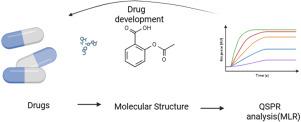Multilinear regression analysis of antiviral medications with topological indices
IF 3
4区 生物学
Q2 BIOCHEMICAL RESEARCH METHODS
引用次数: 0
Abstract
Topological indices are effective tools for modeling and predicting the molecular structure and physicochemical properties of medications, eliminating the need for lengthy laboratory procedures. Topological indices offer the benefit of acting as fundamental numerical indicators in models related to quantitative structure–property relationships (QSPR) and quantitative structure–activity relationships (QSAR). In this research, we investigate degree-based topological indices (TIs) that serve as molecular descriptors for the QSPR analysis of antiviral medications such as Favipiravir, Sertraline, Chloroquine, Ribavirin, Bepridil, Clomifene, Galidesivir, Nilotinib, and Brincidofovir, which affect the interactions between viruses and human proteins. We examine both linear and multilinear QSPR models to analyze the connections between different physical and chemical properties including molecular polarizability (MP), Log P, molecular refractivity (MR), and molecular weight (MW) and the numerical values associated with these drugs. Our results indicate a strong correlation between the topological indices of these antiviral medications and their physical and chemical characteristics.

基于拓扑指标的抗病毒药物多线性回归分析
拓扑指数是建模和预测药物分子结构和物理化学性质的有效工具,消除了冗长的实验室程序的需要。拓扑指数提供了作为定量结构-性质关系(QSPR)和定量结构-活性关系(QSAR)相关模型的基本数值指标的好处。在这项研究中,我们研究了基于程度的拓扑指数(TIs),作为抗病毒药物(如Favipiravir、舍曲林、氯喹、利巴韦林、贝普利地尔、克罗米芬、加利德西韦、尼洛替尼和Brincidofovir) QSPR分析的分子描述子,这些药物影响病毒与人类蛋白质之间的相互作用。我们研究了线性和多线性QSPR模型,以分析不同物理和化学性质之间的联系,包括分子极化率(MP)、logp、分子折射率(MR)和分子量(MW)以及与这些药物相关的数值。我们的研究结果表明,这些抗病毒药物的拓扑指标与其物理和化学特性之间存在很强的相关性。
本文章由计算机程序翻译,如有差异,请以英文原文为准。
求助全文
约1分钟内获得全文
求助全文
来源期刊

Journal of molecular graphics & modelling
生物-计算机:跨学科应用
CiteScore
5.50
自引率
6.90%
发文量
216
审稿时长
35 days
期刊介绍:
The Journal of Molecular Graphics and Modelling is devoted to the publication of papers on the uses of computers in theoretical investigations of molecular structure, function, interaction, and design. The scope of the journal includes all aspects of molecular modeling and computational chemistry, including, for instance, the study of molecular shape and properties, molecular simulations, protein and polymer engineering, drug design, materials design, structure-activity and structure-property relationships, database mining, and compound library design.
As a primary research journal, JMGM seeks to bring new knowledge to the attention of our readers. As such, submissions to the journal need to not only report results, but must draw conclusions and explore implications of the work presented. Authors are strongly encouraged to bear this in mind when preparing manuscripts. Routine applications of standard modelling approaches, providing only very limited new scientific insight, will not meet our criteria for publication. Reproducibility of reported calculations is an important issue. Wherever possible, we urge authors to enhance their papers with Supplementary Data, for example, in QSAR studies machine-readable versions of molecular datasets or in the development of new force-field parameters versions of the topology and force field parameter files. Routine applications of existing methods that do not lead to genuinely new insight will not be considered.
 求助内容:
求助内容: 应助结果提醒方式:
应助结果提醒方式:


